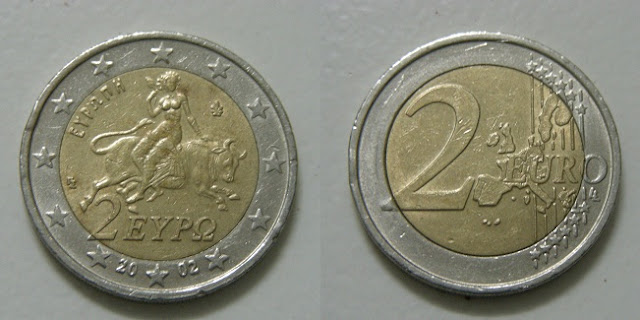The euro (sign: €; code: EUR) is the official currency of the eurozone, which consists of now 17 of the 27 member states of the European Union. It is also the currency used by the Institutions of the European Union. The eurozone consists of Austria, Belgium, Cyprus, Estonia, Finland, France, Germany, Greece, Ireland, Italy, Luxembourg, Malta, the Netherlands, Portugal, Slovakia, Slovenia, and Spain.
The euro was introduced to world financial markets as an accounting currency on 1 January 1999, replacing the former European Currency Unit (ECU) at a ratio of 1:1 (US$1.1743). Euro coins and banknotes entered circulation on 1 January 2002.
The euro is the second largest reserve currency as well as the second most traded currency in the world after the United States dollar.
The euro is the second largest reserve currency as well as the second most traded currency in the world after the United States dollar.
Click here to know more about Euro.
Here are some euro coins in my collection.
Italy: 1Euro (1st Map)

Years: 2002-2007
Metal: Bi-Metallic Copper-nickel plated Nickel center in Brass ring
Weight: 7.50 gm
Diameter: 23.25 mm
Thickness: 2.33 mm
Engravers: Laura Cretara (obverse)
Luc Luycx (reverse)
Metal: Bi-Metallic Copper-nickel plated Nickel center in Brass ring
Weight: 7.50 gm
Diameter: 23.25 mm
Thickness: 2.33 mm
Engravers: Laura Cretara (obverse)
Luc Luycx (reverse)
Obverse features A reproduction of the Vitruvian Man, a world renowned drawing created by Leonardo da Vinci around the year 1492, is encircled by the twelve stars of Europe.
Reverse features A map, next to the facial value, shows the gathering of the fifteen states of the European Union.
 |
| Vitruvian Man by Leonardo da Vinci |
The Vitruvian Man is a drawing created by Leonardo da Vinci in 1487. It is accompanied by notes based on the work of the architect, Vitruvius. The drawing, which is in pen and ink on paper, depicts a male figure in two superimposed positions with his arms and legs apart and simultaneously inscribed in a circle and square. The drawing and text are sometimes called the Canon of Proportions or, less often, Proportions of Man. It is stored in the Gallerie dell'Accademia in Venice, Italy, and, like most works on paper, is displayed only occasionally.
The drawing is based on the correlations of ideal human proportions with geometry described by the ancient Roman architect Vitruvius in Book III of his treatise De Architectura. Vitruvius described the human figure as being the principal source of proportion among the Classical orders of architecture. Leonardo's drawing is traditionally named in honor of the architect.
Click here to know about Vitruvian man.
Click here to know about Italy.
===XX===
Greece: 2 Euro (1st Map)

Years: 2002-2006
Metal: Bi-Metallic Nickel-brass center in Copper-nickel ring
Weight: 8.5 gm
Diameter: 25.75 mm
Thickness: 2.2 mm
Engravers: G. Stamatopoulos (obverse)
L. Luycx (reverse)
Metal: Bi-Metallic Nickel-brass center in Copper-nickel ring
Weight: 8.5 gm
Diameter: 25.75 mm
Thickness: 2.2 mm
Engravers: G. Stamatopoulos (obverse)
L. Luycx (reverse)
Obverse features a representation of the myth of the Abduction of Europa, the daughter of the Phoenician King Agenor, by Zeus, who had taken the form of a bull, is accompanied with the legend "Ευρώπη" (Europa) and the facial value and encircled by the twelve stars of Europe.
Reverse features a map, next to the facial value, shows the fifteen states of the European Union.
Edge: Finely ribbed with edge lettering: "ΕΛΛΗΝΙΚΗ ΔΗΜΟΚΡΑΤΙΑ" (Hellenic Republic).
 |
| Abduction of Europa by Zeus |
In Greek mythology Europa was a Phoenician woman of high lineage, from whom the name of the continent Europe has ultimately been taken.The story of her abduction by Zeus in the form of a white bull was a Cretan story.
The mythographers tell that Zeus was enamored of Europa and decided to seduce or ravish her, the two being near-equivalent in Greek myth. He transformed himself into a tame white bull and mixed in with her father's herds. While Europa and her female attendants were gathering flowers, she saw the bull, caressed his flanks, and eventually got onto his back. Zeus took that opportunity and ran to the sea and swam, with her on his back, to the island of Crete. He then revealed his true identity, and Europa became the first queen of Crete. Zeus gave her a necklace made by Hephaestus and three additional gifts: Talos, Laelaps and a javelin that never missed. Zeus later re-created the shape of the white bull in the stars, which is now known as the constellation Taurus. Some readers interpret as manifestations of this same bull the Cretan beast that was encountered by Heracles, the Marathonian Bull slain by Theseus (and that fathered the Minotaur). Roman mythology adopted the tale of the Raptus, also known as "The Abduction of Europa" and "The Seduction of Europa", substituting the god Jupiter for Zeus.
Click here to know more about Europa.
Click here to know more about Greece.
===XX===
No comments:
Post a Comment